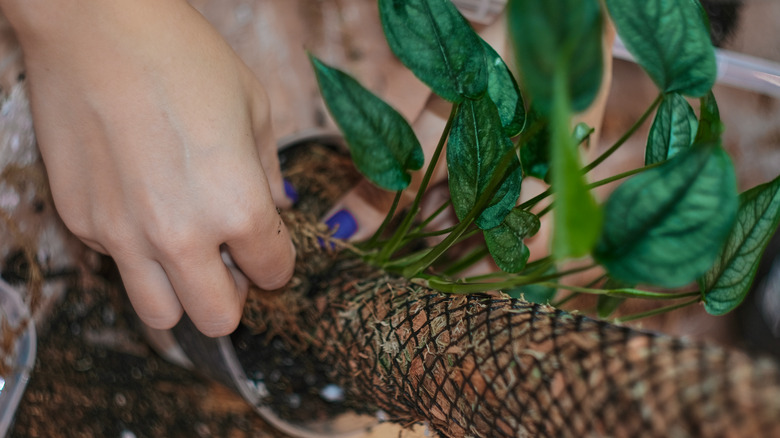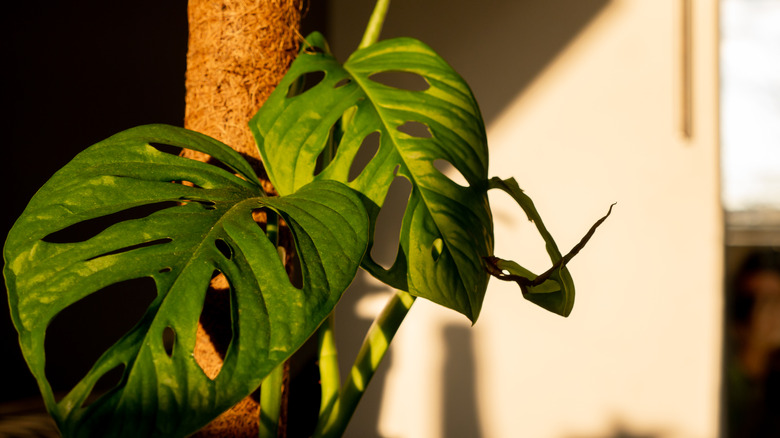Build A Moss Pole To Help Your Plants Thrive With This Genius Pool Noodle Hack
If you're thinking about adding a moss pole to your houseplants, this genius pool noodle hack is going to come in handy. Moss poles can be an unnecessary added expense on top of your plants, pots, and soil when you buy them from the garden center. There are plenty of DIY ideas to help you make your own at home, though, and the pool noodle method is particularly effective and satisfying to put together.
Many people tend to allow trailing plants to hang, but plants that trail benefit greatly from a moss pole or trellis that helps them climb up toward the light. If you're not sure whether your plant is a true hanging or a trailing plant, look for aerial roots along the stem. These are designed by nature to enable trailing plants to grip onto trees so that they can climb up and receive better sunlight, helping them to grow stronger.
Adding a moss pole to your trailing houseplant works in a similar way as a tree, wall, or fence might outside in your garden. When aerial roots come into physical contact with the moss pole, it can actually provide micronutrients and signal the plant to grow even bigger leaves! So if you want to create an urban jungle in your home, moss poles can help grow larger, thriving plants.
How to make a DIY moss pole using a pool noodle
There are many ways to make a DIY moss pole. Girlswholuvgreen on TikTok shows how she made a DIY moss pole using a pool noodle, and followers in the comments were thrilled! To make it, she cuts a pool noodle to the length she wants and then proceeds to poke holes all over with what looks like a screwdriver and a head massager. Then she stuffs some of the moss material into the holes and makes flat sheets to wrap around the pool noodle, securing everything by wrapping twine and knotting tightly. She works in small sections all the way from one end of the pool noodle to the other and finally hangs the pole, adding baby plants by stuffing them into the moss.
When choosing materials to make your moss pole, you can use sphagnum moss, sheet moss, or coconut fiber sheet, along with twine, jute, or fishing line.
Normally moss poles are placed directly into a plant pot so that plants can grow from the soil and climb up the pole. If you have a juvenile plant that isn't ready to climb yet, rather than add the moss pole straight away, you can use this cool hack that uses a surprising bathroom item to help your houseplants thrive – a toilet roll holder! These can make it easier to add a moss pole later on when your baby plant has matured.
Plants that will thrive with a moss pole
In the TikTok video above, the moss pole is suspended in the air, so the plants are growing directly out of the moss instead of climbing up from the soil in a plant pot. She plants baby spider plants, which may be why she poked holes into the pool noodle, providing space for roots to grow and access water soaked into the pool noodle. A hanging moss pole like this could be a good idea for air plants that don't need to be "planted" because they absorb moisture from the air.
Traditionally moss poles are made for trailing plants, though. The monkey mask plant is a perfect example, along with long vines that love to climb up through tropical rainforest canopies in the wild. Similarly, pothos, or "devil's ivy" as it is often called, grows in the same way, and the leaves grow much bigger when they are allowed to climb upwards rather than hang down.
Bigger trailing plants, like the popular monstera, definitely needs the support of a moss pole as it grows bigger. Without it, the plant will grow out of shape and take up a lot of space in a room. You may have to use twine, as the aerial roots only supply vertical support. In the wild, this majestic plant would normally rely on the support of other plants to help it climb up toward the sun.

